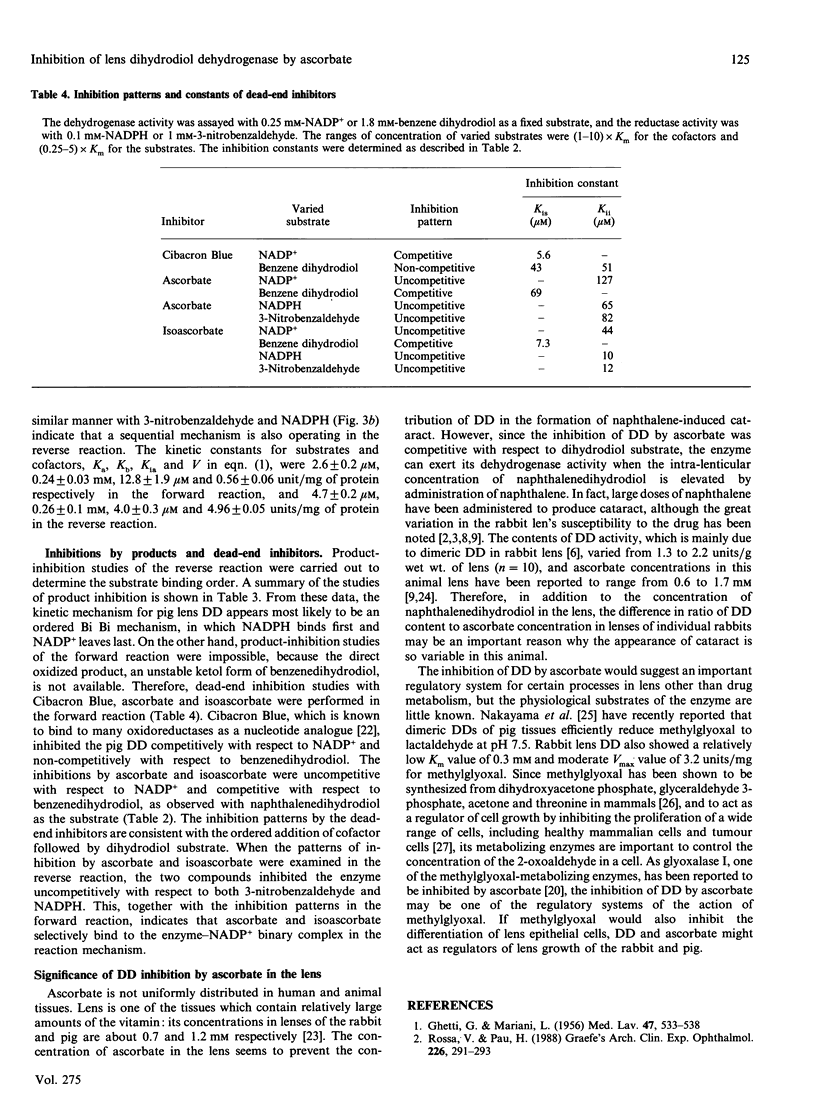Abstract
The dehydrogenase activity of dimeric dihydrodiol dehydrogenases (DD) purified from pig and rabbit lenses was inhibited by either L-ascorbic acid or its epimer, isoascorbic acid, at pH 7.5. Isoascorbate [IC50 (concn. giving 50% inhibition) = 0.043 mM for the pig enzyme; IC50 = 0.13 mM for the rabbit enzyme] was a more potent inhibitor than ascorbate (IC50 values 0.45 and 0.90 mM respectively), but 1 mM-dehydroascorbate gave less than 30% inhibition. Glucose, glucuronate, gulono-gamma-lactone, glutathione and dithiothreitol did not inhibit the enzyme activity. The inhibition by isoascorbate and ascorbate was instantaneous and reversible, and their inhibitory potency was decreased by addition of ascorbate oxidase. In the reverse reaction, isoascorbate and ascorbate gave low IC50 values of 0.013 and 0.10 mM respectively for the pig enzyme and 0.025 and 0.25 mM for the rabbit enzyme. The inhibition patterns by the two compounds were competitive with respect to dihydrodiols of naphthalene and benzene and uncompetitive with respect to NADP+, but those in the reverse reaction were uncompetitive with respect to both carbonyl substrate and NADPH. The steady-state kinetic measurements in the forward and reverse reactions by the pig enzyme were consistent with an ordered Bi Bi mechanism, in which NADP+ binds to the enzyme first and NADPH leaves last. The results indicate that ascorbate and its epimer directly bind to an enzyme: NADP+ binary complex as dead-end inhibitors. Thus ascorbate may be an important modulator of DD in the lens.
Full text
PDF





Selected References
These references are in PubMed. This may not be the complete list of references from this article.
- Beissner R. S., Rudolph F. B. Interaction of Cibacron Blue 3G-A and related dyes with nucleotide-requiring enzymes. Arch Biochem Biophys. 1978 Jul;189(1):76–80. doi: 10.1016/0003-9861(78)90115-7. [DOI] [PubMed] [Google Scholar]
- CLELAND W. W. The kinetics of enzyme-catalyzed reactions with two or more substrates or products. I. Nomenclature and rate equations. Biochim Biophys Acta. 1963 Jan 8;67:104–137. doi: 10.1016/0006-3002(63)91800-6. [DOI] [PubMed] [Google Scholar]
- Fredricks W. W., Kohlmann J. M. Inhibitors of the transhydrogenase activity of spinach ferredoxin-Nicotinamide adenine dinucleotide phosphate reductase. J Biol Chem. 1969 Feb 25;244(4):522–528. [PubMed] [Google Scholar]
- GHETTI G., MARIANI L. Alterazioni oculari da naftalina; ricerche cliniche e sperimentali. Med Lav. 1956 Oct;47(10):533–538. [PubMed] [Google Scholar]
- Hara A., Harada T., Nakagawa M., Matsuura K., Nakayama T., Sawada H. Isolation from pig lens of two proteins with dihydrodiol dehydrogenase and aldehyde reductase activities. Biochem J. 1989 Dec 1;264(2):403–407. doi: 10.1042/bj2640403. [DOI] [PMC free article] [PubMed] [Google Scholar]
- Hara A., Nakayama T., Harada T., Kanazu T., Shinoda M., Deyashiki Y., Sawada H. Distribution and characterization of dihydrodiol dehydrogenases in mammalian ocular tissues. Biochem J. 1991 Apr 1;275(Pt 1):113–119. doi: 10.1042/bj2750113. [DOI] [PMC free article] [PubMed] [Google Scholar]
- Hara A., Nakayama T., Nakagawa M., Inoue Y., Tanabe H., Sawada H. Kinetic and stereochemical studies on reaction mechanism of mouse liver 17 beta-hydroxysteroid dehydrogenases. J Biochem. 1987 Dec;102(6):1585–1592. doi: 10.1093/oxfordjournals.jbchem.a122208. [DOI] [PubMed] [Google Scholar]
- Harwood H. J., Jr, Greene Y. J., Stacpoole P. W. Inhibition of human leukocyte 3-hydroxy-3-methylglutaryl coenzyme A reductase activity by ascorbic acid. An effect mediated by the free radical monodehydroascorbate. J Biol Chem. 1986 Jun 5;261(16):7127–7135. [PubMed] [Google Scholar]
- Iio M., Okabe K., Omura H. Effect of reductones on glyoxalase I1. J Nutr Sci Vitaminol (Tokyo) 1976;22(1):53–61. doi: 10.3177/jnsv.22.53. [DOI] [PubMed] [Google Scholar]
- Kanfer J. N., Spielvogel C. H. The inhibition of beta-N-acetylhexosaminidase by lactones. Biochim Biophys Acta. 1973 Dec 19;327(2):405–411. doi: 10.1016/0005-2744(73)90424-5. [DOI] [PubMed] [Google Scholar]
- Nakayama T., Sawada H., Deyashiki Y., Kanazu T., Hara A., Shinoda M., Matsuura K., Bunai Y., Ohya I. Distribution of dimeric dihydrodiol dehydrogenase in pig tissues and its role in carbonyl metabolism. Adv Exp Med Biol. 1991;284:187–196. doi: 10.1007/978-1-4684-5901-2_21. [DOI] [PubMed] [Google Scholar]
- Rees J. R., Pirie A. Possible reactions of 1,2-naphthaquinone in the eye. Biochem J. 1967 Mar;102(3):853–863. [PMC free article] [PubMed] [Google Scholar]
- Rossa V., Pau H. Is the experimental naphthalene cataract a model for human senile cataract? Graefes Arch Clin Exp Ophthalmol. 1988;226(3):291–293. doi: 10.1007/BF02181199. [DOI] [PubMed] [Google Scholar]
- Schachet M., Squire P. G. Bovine adrenal glucose-6-phosphate dehydrogenase. 3. Control of the activity by ascorbate, substrates, and hydrophobic molecules. Biochim Biophys Acta. 1971 Mar 10;227(3):491–499. doi: 10.1016/0005-2744(71)90002-7. [DOI] [PubMed] [Google Scholar]
- Thompson S. T., Cass K. H., Stellwagen E. Blue dextran-sepharose: an affinity column for the dinucleotide fold in proteins. Proc Natl Acad Sci U S A. 1975 Feb;72(2):669–672. doi: 10.1073/pnas.72.2.669. [DOI] [PMC free article] [PubMed] [Google Scholar]
- VOLK W. A., LARSEN J. L. Bacterial ascorbic acid oxidase. Biochim Biophys Acta. 1963 Apr 9;67:576–580. doi: 10.1016/0006-3002(63)91867-5. [DOI] [PubMed] [Google Scholar]
- Van Heyningen R. Ascorbic acid in the lens of the naphthalene-fed rabbit. Exp Eye Res. 1970 Jan;9(1):38–48. doi: 10.1016/s0014-4835(70)80056-2. [DOI] [PubMed] [Google Scholar]
- Van Heyningen R. Effect of some cyclic hydroxy compounds on the accumulation of ascorbic acid by the rabbit lens in vitro. Exp Eye Res. 1970 Jan;9(1):49–56. doi: 10.1016/s0014-4835(70)80057-4. [DOI] [PubMed] [Google Scholar]
- Van Heyningen R., Pirie A. Naphthalene cataract in pigmented and albino rabbits. Exp Eye Res. 1976 Apr;22(4):393–394. doi: 10.1016/0014-4835(76)90232-3. [DOI] [PubMed] [Google Scholar]
- Van Heyningen R., Pirie A. The metabolism of naphthalene and its toxic effect on the eye. Biochem J. 1967 Mar;102(3):842–852. doi: 10.1042/bj1020842. [DOI] [PMC free article] [PubMed] [Google Scholar]
- van Heyningen R. Naphthalene cataract in rats and rabbits: a resumé. Exp Eye Res. 1979 Apr;28(4):435–439. doi: 10.1016/0014-4835(79)90118-0. [DOI] [PubMed] [Google Scholar]


